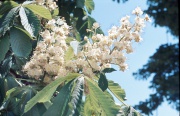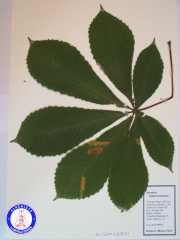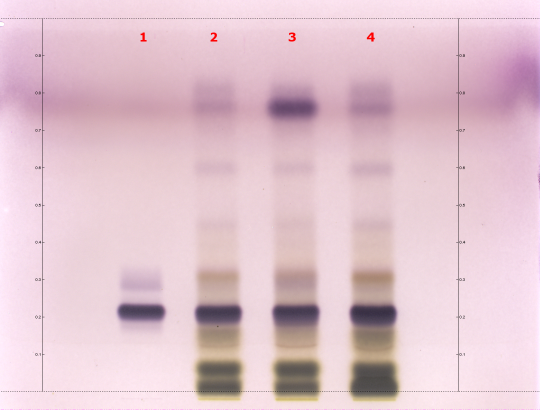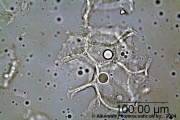From AHPA Botanical Identity References Compendium
(Difference between revisions)
|
|
| Line 1: |
Line 1: |
| | =Introduction= | | =Introduction= |
| − | ''Introduction from Wikipedia, the free encyclopedia (http://en.wikipedia.org/wiki/Aesculus_hippocastanum, retrieved 02/20/2012).''
| |
| − |
| |
| − | ''Aesculus hippocastanum'' is a large deciduous tree, commonly known as Horse-chestnut or Conker tree.
| |
| − |
| |
| − | ''Aesculus hippocastanum'' is native to a small area in the mountains of the Balkans in southeast Europe, in small areas in northern Greece, Albania, the Republic of Macedonia, Serbia, and Bulgaria (Pindus Mountains mixed forests and Balkan mixed forests). It is widely cultivated throughout the temperate world.
| |
| − |
| |
| − | It grows to 36 m tall, with a domed crown of stout branches, on old trees the outer branches often pendulous with curled-up tips. The leaves are opposite and palmately compound, with 5–7 leaflets; each leaflet is 13–30 cm long, making the whole leaf up to 60 cm across, with a 7–20 cm petiole. The leaf scars left on twigs after the leaves have fallen have a distinctive horseshoe shape, complete with seven "nails". The flowers are usually white with a small red spot; they are produced in spring in erect panicles 10–30 cm tall with about 20–50 flowers on each panicle. Usually only 1–5 fruit develop on each panicle; the shell is a green, softly spiky capsule containing one (rarely two or three) nut-like seeds called conkers or horse-chestnuts. Each conker is 2–4 cm diameter, glossy nut-brown with a whitish scar at the base.
| |
| − |
| |
| − | ''The quoted text in this section was licensed for use under the Creative Commons ShareAlike License, version 3.0: http://creativecommons.org/licenses/by-sa/3.0/''
| |
| | =Macroscopic Entries= | | =Macroscopic Entries= |
| | + | {{Macroscopy | source=United States Dispensatory (1918) |
| | + | | description=The seed or nut abounds in starch, but its bitter, disagreeable taste has prevented its general use as a food, |
| | + | although as long ago as 1856 starch was made from it in France, and recently a pleasant and nutritious article of diet is said to have been prepared by removing its bitter principle by means of alcohol. |
| | + | }} |
| | | | |
| | {{Macroscopy | source=MOBOT, Tropicos.org | | {{Macroscopy | source=MOBOT, Tropicos.org |
Revision as of 21:16, 12 December 2013
Introduction
Macroscopic Entries
| The seed or nut abounds in starch, but its bitter, disagreeable taste has prevented its general use as a food,
although as long ago as 1856 starch was made from it in France, and recently a pleasant and nutritious article of diet is said to have been prepared by removing its bitter principle by means of alcohol.
Source: United States Dispensatory (1918) [1]
|
|
|
|
| Achillea millefolium - Tropicos.org (Solomon, James Clinton - 30)
Reference see Tropicos.org. Missouri Botanical Garden. 05 Aug 2013 <http://www.tropicos.org/Image/35153>
Source: MOBOT, Tropicos.org [2]
|
|

Achillea millefolium - Tropicos.org (Solomon, James Clinton - 30)
|
|
| Horse Chestnut (leaf) Botanical Voucher Specimen - Alkemists Laboratories
Source: Botanical Voucher Specimen Library, Alkemists Laboratories [3]
|
|

Horse Chestnut (leaf) Botanical Voucher Specimen - Alkemists Laboratories
|
|
Microscopic Entries
| Large thin-walled parenchyma showing intercellular spaces of Aesculus hippocastanum seed viewed at 400x with Acidified Chloral Hydrate Solution.
Source: Elan M. Sudberg, Alkemist Laboratories [4]
|
|
|
|
HPTLC Entries

Horse Chestnut HPTLC ID - Anisaldehyde Reagent, White RT.
Horse Chestnut (seed) (Aesculus hippocastanum)
Lane Assignments Lanes, from left to right (Track, Volume, Sample):
- 10 μL Escin
- 10 μL Horse Chestnut whole 1
- 10 μL Horse Chestnut powder
- 12 μL Horse Chestnut whole 2
Reference Sample(s) Reference: Dissolve 15 mg of escin in 3 mL of methanol.
Stationary Phase Stationary phase, i.e. Silica gel 60, F254
Mobile Phase 1-butanol, water, glacial acetic acid 50:40:10 (v/v/v)
Sample Preparation Method Sample: Mix 1 g of powdered sample with 10 mL of ethanol-water (7:3), heat on a steam bath for 10 minutes, then centrifuge or filter the solutions and use the supernatants / filtrates as test solutions
Anisaldehyde Reagent Preparation: 1mL anisaldehyde reagent, 20mL acetic acid 99%, 170mL methanol, 10ml sulfuric acid 95%-97%
Detection Method Anisaldehyde Reagent Use: Dip (time 0, speed 5), heat at 100°C for 4 min
Other Notes Compare result under white RT with reference images in Image Comparison Viewer. The fingerprint of the test solution is similar to that of the corresponding botanical reference sample. Additional weak zones may be present.
A. hippocastanum Identification: Above the zone due to escin the chromatogram shows several narrow, brown to brownish-red zones that are less intense than the zone corresponding to escin.
Source: CAMAG HPTLC [5]
|
Other Points of Interest
Cite error: <ref> tags exist, but no <references/> tag was found





